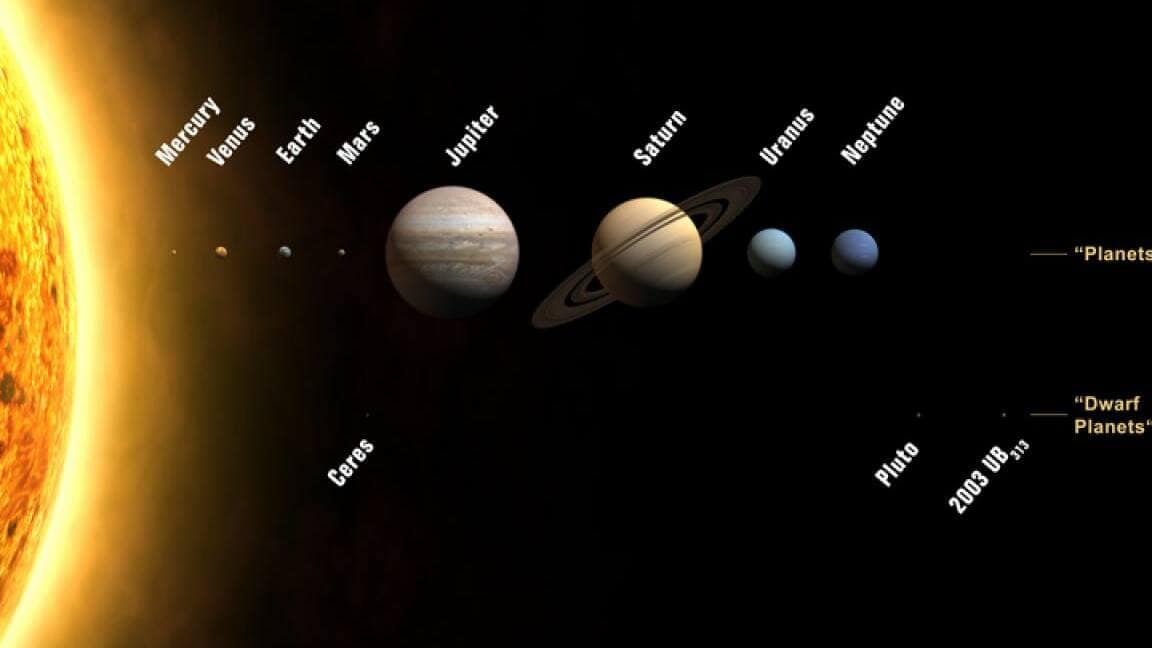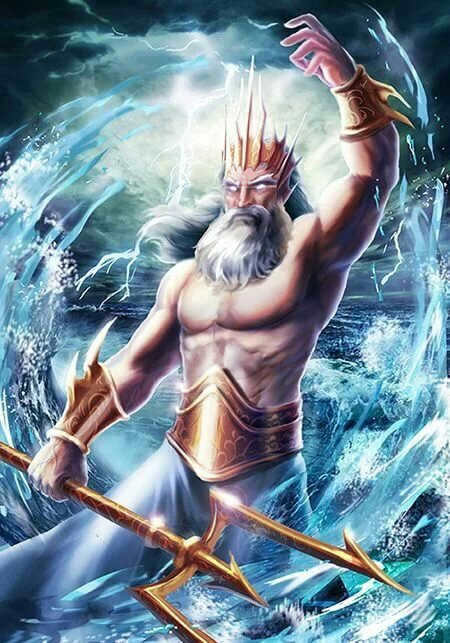
Hello there, esteemed readers – enthusiasts and devotees of the fables of myths and folklore. Presently, we yearn to immerse ourselves into the expansive realm of Roman mythology and once more exhibit to you that notwithstanding the complete resemblance, the methodology pertaining to the tales of these two civilizations varied markedly. In the present day, we shall converse about the sovereign of the vast expanse of the seas and oceans, rivers and rivulets, none other than Neptune.
Origin
The birth of Neptune was a tragic event, marked by sadness. Immediately after his birth, his father Saturn devoured him, along with his siblings, out of fear that one of them would challenge his power. Neptune spent a long time trapped in his father’s stomach, where he experienced his childhood and youth. It wasn’t until his brother Jupiter intervened and convinced Saturn to release them all.
It should be noted that Roman mythology differs significantly from Greek mythology. This is primarily because Roman mythology omits a significant portion of the divine wars and achievements found in Greek mythology. While the gods in both Roman and Greek mythologies have similar roles and functions, their significance and interpretations vary greatly.

In the beginning, the pantheon included Oceanus, the god who reigned over the depths of the sea. Naturally, he was not willing to share his power with his nephew. It was only when his nephew married the goddess of salt water that he allowed him to govern the seas and oceans.
Originally, Neptune was worshipped as the god of all flowing waters, without exception. As Greek culture and mythology heavily influenced Roman culture, Neptune took on all the roles and responsibilities of Poseidon, and became a more prominent deity in the Roman pantheon. However, Neptune gained even more popularity and fame as the patron god of horses and chariot races.
The Transformation of Neptune
As previously mentioned, Neptune initially had limited popularity and was primarily associated with rivers and springs. However, according to Roman mythology, there is little information regarding the division of the world among the three brothers (Jupiter, Pluto, and Neptune). It is believed that Neptune only became the god of the seas and oceans after marrying Salacia, who was revered as the goddess of salt water.
Following this union, Neptune’s significance in Roman mythology gradually grew, yet it still did not surpass that of the other supreme deities. Coastal cities were particularly fond of Neptune, and it took several years for his popularity to spread throughout the entire Roman Empire.
The Neptunalia, an annual sports event held on July 23 in honor of the sea god Neptune, paid tribute to the deity Neptune. In addition, a magnificent temple was built for him on the Field of Mars, boasting unique construction and architecture that was truly breathtaking. However, despite its splendor, Neptune never achieved the status of a supreme deity during the Roman Empire, and was primarily worshipped by sailors and coastal dwellers.
The Romans’ perception of Neptune can be fully illustrated by an intriguing legend. In ancient Rome, there was a bold and renowned emperor named Caligula. He may be considered one of the most influential autocrats in history, and his character sheds light on the topic at hand. Caligula, at one point, proclaimed himself as a deity. He was so proud of this newfound status that he believed he had the authority to wage war against other gods. As a result, he assembled a massive army, led them to the strait which we now know as the English Channel, organized them in battle formation, and commanded them to attack the water.
Throughout the entire day, the fighters vigorously slashed at the water using their swords, thrust their spears into its depths, battered it with their shields and daggers, and even hurled their darts into the vast expanse. Yet, Neptune remained unresponsive. As a result, when the sun began its descent, Caligula proclaimed himself victorious over Neptune. This tale, above all others, exemplifies the Romans’ perspective on Neptune. In contrast, the Greeks, with their advanced and influential maritime culture, would have never dared to treat Poseidon in such a manner.
Neptune, the god of the seas, is easily recognizable by his main attribute, the trident. He appears as a powerful and muscular man, with a full beard and long hair. At times, he adorns a sea crown on his head. His gaze carries weight and his temperament is fierce, embodying the regality befitting the ruler of the oceans.
In contrast to other gods, Neptune does not wear the traditional Roman and Greek togas. Instead, he is seen with a bandage covering his lower body down to his heels. This may explain why some ancient paintings depict Neptune with a fish tail, although modern scholars argue that this depiction actually belongs to his son, Triton. Neptune himself possesses human legs, aligning with the mythology that he was born not in the water, but in the sky.
Speaking of Neptune’s attributes, undoubtedly, his most famous one is his trident, which possessed the power to create and calm storms at his command. Additionally, he was often depicted with a chariot resembling a shell, pulled by four magnificent horses with either white or golden horns and bronze hooves.
However, Neptune’s character was less than desirable. He was known for his vengefulness, cruelty, irritability, and even a touch of envy. Due to his temperament, he fell out of favor with the other gods, resulting in his banishment to reside separately within the vast expanses of the sea. Nevertheless, this did not prevent him from getting entangled in numerous scandals, which we will delve into below.
As previously stated, Neptune frequently found himself in predicaments due to his spirited nature. Naturally, this led to a plethora of Greek myths that eventually transformed into Roman legends.
The Tale of Neptune and Jupiter
After enduring Jupiter’s constant cheating and mischievous behavior, Juno’s patience finally reached its limit. In response, Juno decided to organize a rebellion, which quickly gained support from Neptune, who had a penchant for conspiracy, and Apollo, who was dissatisfied with his father’s authority. Unfortunately, the uprising was unsuccessful and the conspirators faced severe consequences for their actions.
Juno was subsequently suspended in the air between the heavens and the earth, held by golden chains. Meanwhile, Neptune and Apollo were banished to Troy, where they were tasked with constructing the city’s formidable walls. As a result, Troy’s walls were deemed impenetrable due to the divine involvement and tremendous effort put forth by the gods in their construction.

It is a matter of fact that the deities were dispatched to the fortifications of Troy, assuming the roles of common laborers, due to an audacious insurrection. Laomedontes was not under obligation to remunerate them, but in order to extract more productivity from the gods, he pledged them presents and rituals. However, he failed to fulfill his promise, resulting in dire consequences for his subjects…..
During that period, Troy was under the rule of King Laomedontes, who had gained a reputation for his extreme greediness. Despite the fact that Neptune and Apollo had been obligated to provide their services to the king, he had made a solemn promise to reward them generously for their assistance. However, when the time came for him to fulfill his promise, Laomedontes refused to give the gods what he had pledged. This act of betrayal angered the vengeful and merciless Neptune, who decided to take revenge on the Trojans by creating a monstrous serpent and unleashing it upon the city. The serpent wreaked havoc in the territory of Troy for a considerable period of time, until Laomedontes sought guidance from the oracles. They informed him that the serpent would only be appeased if a young girl were to be sacrificed to it.
Neptune and the dispute
Following their exile, Neptune and Apollo returned from banishment. Juno was also pardoned, but all of them were required to swear allegiance to Jupiter and promise never to attempt to overthrow him again. Neptune, along with the others, took this oath, but it did not dampen his enthusiasm in the slightest; in fact, it only made him more determined.
Next came the matter of Athens. To prevent any conflicts among the gods, Jupiter decreed that each god should choose a city where they would be most worshipped. Neptune and Minerva both favored a coastal town that was nameless at the time. The locals were to decide which god to honor, and unfortunately for Neptune, they preferred Minerva’s olive tree over his water source.
Enraged Neptune withdrew to his realm, and the people of Athens (as the city was called), for an extended period, went to great lengths to appease him with offerings and rituals, resulting in the sea ruler granting them the ability to navigate the waters without harm.
Subsequently, Neptune also engaged in disputes with Minerva regarding the possession of Tresenus, and with Apollo regarding the ownership of Corinth.
Mythology gives a lot of importance to the romantic relationships of the deities, which are often full of surprises and fascinating. In this aspect, Neptune comes in second only to Jupiter, who had a penchant for women.
Neptune and Ceres – A Tale of Love
Neptune used to be alone in the depths of the sea for a considerable period of time. However, everything changed when he encountered the stunning Ceres. Unfortunately, the goddess had no desire to become involved with a god who had a volatile temper. In order to escape his advances, she transformed herself into a mare. Despite this, Neptune remained unwavering in his pursuit. He transformed himself into a horse and continued to chase after Ceres, declaring his love for her.
Eventually, their relationship did progress, but in the form of horses. As a result of their union, the world was introduced to the magnificent Arion, a winged horse with the ability to speak. Subsequently, this horse was captured by Hercules and Adrastus, both of whom he served admirably.
Neptune and Theophanes
Neptune and Theophanes are two characters who play a significant role in the story. These two individuals have different backgrounds and personalities, but they are brought together by a common goal. Neptune, a powerful god of the sea, is known for his strength and dominance. Theophanes, on the other hand, is a humble fisherman who has a deep respect for the ocean and its creatures. Despite their differences, Neptune and Theophanes develop a deep bond and work together to protect the marine life and preserve the balance of nature. Their unique partnership serves as an example of how individuals from different backgrounds can come together for a greater cause.
Neptune did not lack interest in mortal women. For instance, there was a time when he developed deep affection for the exquisite Theophana. His emotions were so intense that he transformed the young woman into a sheep to ensure that no one else could exploit her beauty. He transported her to a distant island, and in order to fulfill his desires, he assumed the form of a sheep himself. As a result of their union, Theophana gave birth to a remarkably beautiful ram with shimmering golden wool. In the future, this ram, or more accurately, its wool (known as the golden fleece), would become the basis for another legendary Greek tale concerning the Argonauts.
Neptune and Medusa Gorgon
can be rephrased as:
Neptune and the Gorgon Medusa
According to a popular legend, Neptune is believed to be responsible for the transformation of Medusa Gorgon into a fearsome monster, whose mere gaze could petrify anyone. The story goes that Medusa had been rejecting Neptune’s advances for a long time, but the god was relentless in his pursuit. In an attempt to escape his grasp, Medusa sought refuge in the temple of Minerva and sought sanctuary there. However, Neptune, determined to have his way, transformed into a bird and violated Medusa within the sacred walls of the temple. Outraged by Medusa’s defilement of her holy sanctuary, Minerva punished her by turning her into a terrifying monster…
Neptune’s mischievous nature so “vilified” him that even in situations where his intentions were more serious, girls were hesitant to believe him. This was the case with Neptune’s future wife, Salacia. For a considerable period of time, the nereid eluded the sea lord, scarcely giving him a chance to approach her.
However, on this occasion, Neptune refrained from using force. Instead, he dispatched a dolphin to Nereida, who conveyed to the girl Neptune’s true feelings for her. Salacia was so deeply moved by Neptune’s genuine and profound emotions that she consented to become his spouse. In due course, they bore Triton, a deity possessing the body of a man and the tail of a fish.
Idas and Marpessa
Idas and Marpessa were a couple who were deeply in love with each other. They were known for their strong bond and unbreakable connection. Their story is one of passion and devotion, which has been immortalized in various works of art and literature.
Idas was a brave and strong warrior, known for his courage and skill in battle. Marpessa, on the other hand, was a beautiful and enchanting woman, admired by all who saw her. Despite their differences, they were drawn to each other like magnets, unable to resist the pull of their love.
Their love was not without obstacles, however. Marpessa was courted by Apollo, the god of music and poetry, who was determined to win her heart. He offered her immortality and eternal youth, promising her a life of luxury and pleasure. But Marpessa, true to her love for Idas, refused Apollo’s advances.
This rejection enraged Apollo, who became consumed with jealousy and anger. He tried to take Marpessa by force, but Idas, ever the protector, fought back fiercely. The two engaged in a fierce battle, with Idas using his strength and skill to defend his beloved Marpessa.
In the end, love triumphed over all. Idas and Marpessa’s bond proved to be unbreakable, and they were able to overcome every obstacle in their path. Their love story serves as a reminder of the power of love and the strength of the human spirit.
Today, Idas and Marpessa are remembered as symbols of true love and devotion. Their story continues to inspire and captivate people of all ages, reminding us of the beauty and power of love.
Neptune, being one of those deities who enjoyed observing the events in the mortal realm, was always eager to make things more interesting. This time, he decided to assist Idas.
One fine day, Idas approached Neptune, requesting to borrow his renowned chariot. When the god inquired about the reason behind this favor, Idas confessed that he had fallen deeply in love with Marpessa, the daughter of King Ewen. Despite their mutual affection, Marpessa’s father vehemently opposed their union.
Neptune consented to assist Idas and bestowed upon him his chariot, which was pulled by four exquisite horses. With little trouble, Idas successfully abducted Marpessa. Ewen, upon realizing his daughter’s absence, pursued her, but he was no match for the celestial chariot. Consumed by fury, he flung himself into the river and met his watery demise. Consequently, the river has been christened in his honor.
However, the journey of the lovers was short-lived. The chariot came to a halt as Apollo, who had been observing the beautiful Marpessa for quite some time, decided that he too desired her affections. However, Idas, unwilling to give up his beloved without a fight, was prepared to confront the god. Suddenly, thunder echoed through the sky. It was Jupiter, who declared that it was unjust for a god to deny a mortal their happiness. Jupiter wisely suggested that Marpessa herself should have the freedom to choose her own fate. After careful consideration, the girl selected a mortal with whom she could share her life and grow old with. Apollo reluctantly accepted this defeat.
Following this, Idas returned the chariot to Neptune and expressed his heartfelt gratitude for the god’s assistance. In return, Neptune enjoyed a splendid time at Idas and Marpessa’s wedding, attended by a multitude of sea and river dwellers.
Frequently Asked Questions
If we consider Greek mythology, it was Neptune or Pluto who should have assumed the role of the supreme deity, not Jupiter. However, due to the whims of fate, Jupiter managed to save his brothers and was rewarded with power over the world. Neptune had aspirations that extended beyond control over water, but it is unlikely that anyone would have granted him the opportunity to seize it.
The Romans rarely concerned themselves with naval battles. They were much more focused on land battles and conquests, unlike the Greeks who heavily relied on sea campaigns. This is why Poseidon, in Greek mythology, holds more power than Neptune in Roman mythology.
One might characterize it as a feeling of powerlessness. Neptune had a strong desire to govern and acquire new lands, so he frequently meddled in the affairs of other deities and sought to justify his actions. However, his efforts were often unsuccessful because justice did not always favor him. This was evident in the tales involving Minerva and Apollo.

Pisces represents the realm of mysticism and the world of dreams. Those who are born under the Pisces sign often rely heavily on their emotions and intuition, placing a high value on spiritual aspects of life. While Jupiter was traditionally associated with the Pisces sign, it is now widely believed that Neptune is the ruling planet of Pisces.
The ruling planets of Pisces are Neptune and Jupiter.
Each astrological sign is associated with one or more planets. In the case of Pisces, these planets are Neptune and Jupiter. These two planets are the largest in our solar system.
According to mythology, Neptune is connected to the god of the sea and the Water element. In Pisces, Neptune’s gentle yet powerful energy is revealed. This energy is associated with compassion, kindness, and a desire to help others.
Pisces individuals are known for attracting many friends and maintaining warm relationships with them. They often become a shoulder to cry on for their loved ones, offering support and understanding. Pisces individuals are trustworthy and can keep secrets confidential.
It is worth noting that Pisces individuals, influenced by Neptune, are tactful and modest. They do not intrude into other people’s lives without permission.
Neptune bestows strength upon Pisces and serves as a wellspring of inspiration for their creativity, igniting the birth of their most brilliant and thriving projects. It encompasses all the finest qualities that fortify the vitality of Pisces, while also unveiling their tender traits, such as warmth and love.
What are the qualities that Neptune grants to Pisces?
Neptune, positioned as the penultimate eighth planet from the Sun, boasts a diameter almost four times larger than that of Earth. In line with other planets of considerable size (Neptune’s diameter measures a staggering 49,000 kilometers), it also possesses its own set of “rings”. The planet Pisces completes one full rotation on its axis in 15 hours and 48 minutes, and takes 164 years (in Earth years) and 280 days to complete a full orbit around the sun.
A unique characteristic of the planet is that it appears as a greenish-blue celestial body that is not visible to the naked eye, but can only be observed with the aid of a telescope.
In terms of mythology, the planet is associated with the gods Poseidon and Neptune. Poseidon is the deity of volcanoes, earthquakes, and other natural disasters, representing the purity of water. Neptune, on the other hand, is the god of lakes, rivers, oceans, and the sea, embodying the mysterious and creative forces of water.
Astrologically, the influence of the planet Pisces endows individuals born under this zodiac sign with a heightened sensitivity, drawing them away from earthly troubles and into the enigmatic and shadowy depths. Throughout human history, water has been intertwined with numerous significant events and phenomena.
Aside from the well-known Flood, which is mentioned in nearly every ancient text, historians are increasingly referring to the original waters as the origin of life. The Book of Genesis speaks of God’s breath gliding over the water. The Hindus mention vast and infinite waters in their scriptures, and Chinese records also make reference to the original waters.
The god Neptune symbolizes fertility. He had numerous lovers and generally only produced monsters.
Neptune embodies psychic activity, supernatural abilities, female intuition, and psychic sensitivity. All of these qualities are possessed by representatives of this zodiac sign. The Greek god Poseidon had such a nature that also aligns very well with all of these traits.
Pisces, whose ruling planet is Neptune, possesses a strong inclination towards secrets, hypersensitivity, and destructive power.
The planet Neptune governs romance, mysticism, and contemplation in the realm of Pisces. It manifests through spiritual communication, dreams, the subconscious mind, the human biofield, and drug-induced hallucinations.
The Influence of Jupiter on the Qualities of Pisces
Just like the mighty Neptune, the planet Jupiter has a significant impact on the zodiac sign of Pisces. It bestows upon Pisces qualities such as generosity, a broad soul, nobility, piety, kindness, a love for pleasure, respectful free-thinking, and a sense of justice. Additionally, it instills self-esteem, sublimity, tolerance, affection, and a love for debate.
However, if Pisces experiences conflicting emotions, it may possess qualities that are completely opposite to those mentioned above. For instance, instead of modesty, it may exhibit cowardice; instead of cordiality, it may display naive simplicity; instead of a love for beauty, it may prioritize pleasure; and instead of generosity, it may demonstrate indifference.
The mighty planet Jupiter, which also represents growth, pushing boundaries, progress, is therefore connected to exploration. In the case of Pisces, this planet is a symbol of faith, as only faith can propel a person forward when faced with the forbidden and unexplained.
Jupiter instills a sense of spirituality in the souls of Pisces, imparting a positive outlook and, in certain texts, it is likened to a spiritual guide. Pisces, under the immense influence of Jupiter, can tap into their inner strength and experience a sense of fulfillment.
As it is widely acknowledged, Jupiter holds the title of being the largest planet within the solar system. The sheer magnitude of this celestial body is truly awe-inspiring, making it an unmatched force among its planetary counterparts. However, it is worth noting that there have been recent discoveries of planets that surpass even Jupiter in size. Nevertheless, pinpointing the precise dimensions of Jupiter remains an arduous task due to various factors….
The largest planet in the solar system, known as Jupiter, remains a mystery when it comes to its true size. The planet’s thick atmosphere, filled with ongoing chemical reactions, poses a challenge in accurately measuring its size. Although we observe Jupiter’s clouds, which are often mistaken for its actual size, the true dimensions of the planet may be much smaller than what meets the eye.
The dense clouds surrounding Jupiter make it difficult to discern its surface, which is crucial in determining the planet’s size. To overcome this obstacle, scientists rely on data collected from probes orbiting Jupiter to estimate the size of its surface and, consequently, the overall size of the planet.
The dimensions of Jupiter and Earth
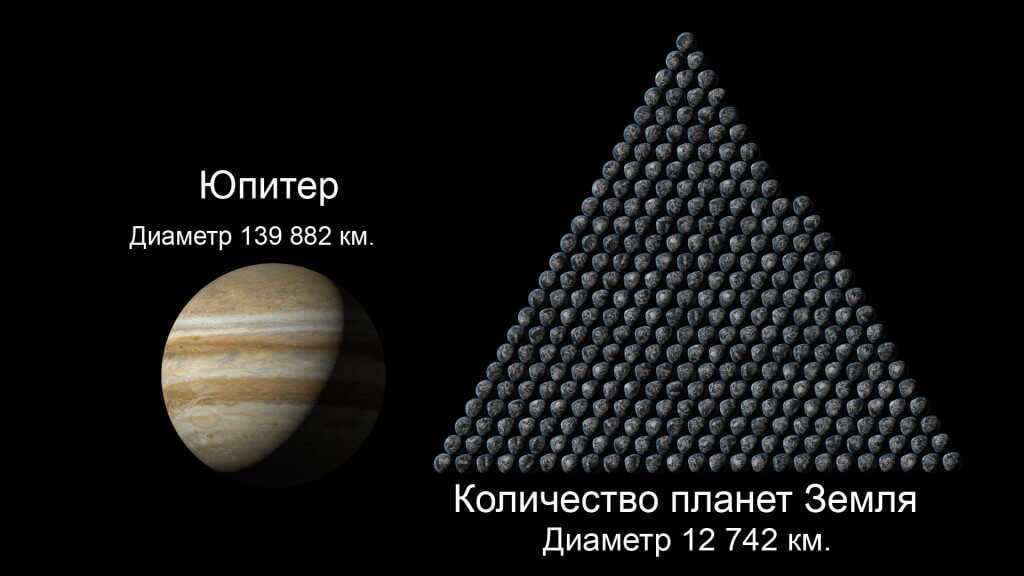
Jupiter is 318 times larger than Earth. Its mass is so huge that it can attract objects passing by. Due to its mass, Jupiter acts as a protector and has attracted and absorbed various space objects that were heading towards Earth. Without Jupiter, more meteorites and asteroids could have reached Earth and posed a threat to our lives. Jupiter’s size also allows it to have numerous satellites in its orbits.
Therefore, Jupiter’s size has potentially saved our planet numerous times. If it wasn’t for Jupiter, life on Earth might have been destroyed by a meteorite long ago.
While Jupiter holds the title for being the largest planet in our solar system, it is fascinating to note that there are planets in other star systems that surpass Jupiter in size. What sets these planets apart is not only their massive dimensions, but also their close proximity to their respective stars. Due to their close proximity, these gas giants experience significantly higher temperatures compared to Jupiter, which further amplifies their colossal nature. One such example is TRES-4, which stands as the largest known planet in existence.
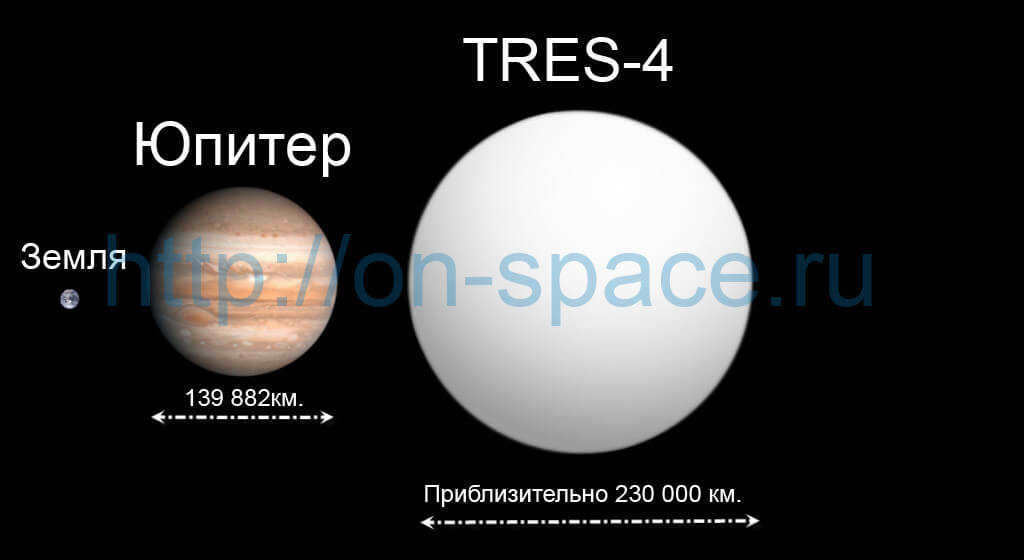
Even without specialized astronomical equipment, it is possible to ascertain the relative size of Jupiter in comparison to Earth. This can be done by simply observing images of the colossal celestial body, which possesses well-defined boundaries.
The challenge of measuring the magnitude of the planet
Accurately determining the size of Jupiter presents a difficulty due to its composition as a gaseous sphere. The chemical components within its atmosphere and on its surface (which is comprised of a Global Ocean) are in a constant state of transformation, transitioning from gaseous to molten forms.
In the upper layers of the atmosphere, which appear to be the visible limits of the object, the ongoing processes cannot be accurately determined due to the dense clouds. Therefore, all calculations are based solely on research data, assuming that the dimensions of Jupiter are equivalent to the contour of its visible cloud boundary.
The radii characterize the dimensions of this celestial body:
- Equatorial radius: 69,911 km
- Polar radius: 66,854 km
- Mean radius: 69,911 km
These dimensions are applicable to Jupiter’s current position. If it were closer to the Sun, its diameter would be larger due to increased heating from sunlight, causing the gases to expand.
The shape of the celestial body is slightly distorted on the side of the pole due to its rapid rotation around its axis (completing a full revolution in just 10 hours). Jupiter’s geometric shape is referred to as a oblate spheroid.
In order to simplify calculations, scientists have considered Jupiter to be a gas giant with a diameter of nearly 140,000 km. This simplifies the task as the planet’s surface lacks mountains and valleys, unlike rocky celestial bodies.
If you were to line up 11 planets similar in size to Earth, it would approximately match Jupiter’s diameter. Credit: NASA.
On average, the size of this celestial body is approximately 139822 km, which is nearly 11 times larger than the Earth. The well-known hurricane that travels around the planet – BKP – has had various lengths ranging from 24000 to 40000 km in different years. Our planet, with its average radius of 6371 km, would simply be engulfed by this atmospheric phenomenon.
If any spacecraft decides to orbit this planet, it would have to travel more than 440000 km. For comparison – if it orbited the Earth along its equator, it would cover a distance 10 times smaller.
There is a celestial object in outer space that surpasses Jupiter in size. TrES-4, an exoplanet detected in the 2000s, is situated in the Hercules constellation. It is also a gas giant and exceeds our own “giant” by 1.8 times in terms of size. However, within our solar system, Jupiter is not the largest celestial body as it is ten times smaller than the Sun in terms of radius.
Volume and area
A mathematical formula can be used to compare the volume of Jupiter and Earth by knowing the diameters of these celestial bodies. Calculations indicate that the gas giant is approximately 1300 times larger than our planet.
Applying the same formula, it can be determined that Jupiter’s surface area is 122 times greater than Earth’s.
The Planets’ Masses
Regarding mass, the giant planet is 318 times larger than our planet. It is twice as heavy as the combined weight of Pluto, Saturn, Uranus, Neptune, Mars, Earth, Venus, and Mercury. However, Jupiter is still much smaller than the Sun, which accounts for approximately 99.86% of the entire solar system’s mass.
The mass of the giant planet was theoretically calculated based on the following parameters:
An additional 1% is attributed to a mixture of various gases and water vapor, so an average of their masses was utilized in the calculations.
However, Jupiter does not hold the absolute record for density. In terms of this parameter, it ranks fifth in the solar system. Despite its apparent enormity, the planet is relatively “loose” since it is composed of gases rather than solid rocks.
Underneath this region lies a layer of hydrogen in a gas-liquid state. This particular layer is distinguished by the transformation of gaseous substance into liquid as it delves further. The scientific community is currently unable to elucidate this process in terms of physics. It is well-established that hydrogen exists solely as a gas at temperatures exceeding 33 K. Nevertheless, Jupiter wholly undermines this principle.
In the lowermost part of the hydrogen layer, the pressure reaches 700000 atmospheres, and the temperature rises to 6500 K. Below that lies an expanse of liquid hydrogen devoid of any trace of gas. Further down is ionized hydrogen, having disintegrated into atoms. This accounts for the planet’s robust magnetic field.
The mass of Jupiter is well-known, however, determining the exact mass of its core poses a challenge. Scientists speculate that it could be anywhere from 5 to 15 times the size of Earth. The core of Jupiter has incredibly high temperatures, reaching 25,000-30,000 degrees, and is under immense pressure of 70 million atmospheres.
Atmosphere
The presence of red-hued clouds on Jupiter suggests that its atmosphere consists not only of hydrogen, but also complex compounds. Methane, ammonia, and even water vapor particles can be found in the planet’s atmosphere. Furthermore, traces of ethane, phosphine, carbon monoxide, propane, and acetylene have been detected. It is challenging to pinpoint the exact compound responsible for the original color of the clouds, as it could be sulfur compounds, organic matter, or phosphorus compounds.
The multidirectional atmospheric currents on Jupiter, which run parallel to the planet’s equator, are characterized by alternating light and dark stripes. These currents can reach speeds of up to 100 meters per second. The boundary between these currents is marked by large swirling patterns, with the most impressive being the Great Red Spot. This massive vortex has been active for over 300 years and measures approximately 15×30 thousand kilometers in size. Its exact lifespan remains unknown, but it is believed to have persisted for thousands of years. The Great Red Spot completes a full revolution around its axis in just one week. While Jupiter’s atmosphere contains other similar vortices, they are significantly smaller and have a much shorter lifespan, typically lasting no longer than two years.
Ring
can be paraphrased as
Jewelry
or
Finger ornament
.
Earth’s Magnetic Field
Due to its mass, radius, and chemical composition, Jupiter possesses a massive magnetic field that surpasses Earth’s in strength. In fact, Jupiter’s magnetosphere extends far into space, reaching a distance of approximately 650 million kilometers, extending beyond Saturn’s orbit. However, in the direction towards the Sun, this distance is reduced by a factor of 40. Therefore, even at such immense distances, the Sun doesn’t exert a significant influence on Jupiter. This unique behavior of Jupiter’s magnetosphere sets it apart from a typical spherical shape.
Is Jupiter on its way to becoming a star?
Although it may seem far-fetched, there is a possibility that Jupiter could transform into a star. A hypothesis put forward by a scientist suggests that this massive planet possesses a source of nuclear energy.
However, it is well-known that planets do not have their own sources of energy. They are visible in the sky due to sunlight reflection. In contrast, Jupiter emits more energy than it receives from the Sun.
Some scientists speculate that in approximately 3 billion years, Jupiter will attain the same mass as the Sun. This would result in a catastrophic event, leading to the demise of the current solar system as we know it.
Characteristics of the Planet:
- Distance from the Sun:~778.3 million kilometers
- Diameter of Jupiter:143,000 km *
- Length of a day on Jupiter:9h 50min 30s **
- Length of a year on Jupiter:11.86 years ***
- Surface temperature:-150°C
- Atmosphere composition:82% hydrogen; 18% helium and minor traces of other elements
- Satellites:16
* Diameter measured at Jupiter’s equator
** Rotation period around its own axis (in Earth days)
*** Orbital period around the Sun (in Earth days)
Jupiter is the fifth planet from the Sun. It is located at a distance of 5.2 astronomical units from the Sun, which is about 775 million kilometers. Astronomers classify the planets of the Solar System into two groups: terrestrial planets and gas giants. Jupiter is the largest planet among the gas giants.
Jupiter is 318 times the size of Earth, and if it were approximately 60 times larger, it would possess a significant probability of transforming into a star through a spontaneous thermonuclear reaction. The composition of the planet’s atmosphere consists of approximately 85% hydrogen, while the remaining 15% primarily consists of helium, along with compounds of ammonia, sulfur, and phosphorus. Additionally, methane can also be found within Jupiter’s atmospheric layers.
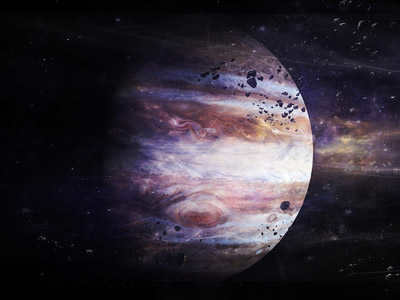
Using spectral analysis, scientists have determined that there is a lack of oxygen on Jupiter, which means there is no water – the essential element for life. However, an alternative theory suggests that there may be ice in Jupiter’s atmosphere. Jupiter has long been a subject of debate among scientists, particularly when it comes to its internal structure. Recent studies conducted with the help of spacecraft have provided valuable insights and allowed researchers to develop a model that provides a more accurate understanding of Jupiter’s composition.
Structure within
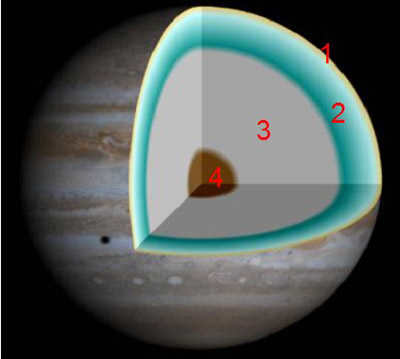
Jupiter is a celestial body that possesses the shape of a spheroid, with a significant amount of compression at its poles. Its magnetic field is incredibly powerful, stretching millions of kilometers beyond its orbit. The atmosphere of Jupiter consists of alternating layers with distinct physical properties. Researchers propose that Jupiter contains a compact core, estimated to be approximately 1-1.5 times the diameter of Earth, but with much greater density. Although the existence of this core has yet to be definitively proven, it also has not been disproven.
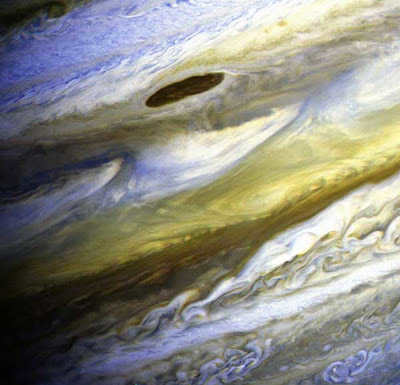
The uppermost layer of Jupiter’s atmosphere is composed of a blend of hydrogen and helium gases and measures between 8 and 20 thousand kilometers in thickness. In the subsequent layer, which has a thickness of 50 to 60 thousand kilometers, the gas mixture transitions to a liquid state due to heightened pressure. Within this layer, temperatures can reach as high as 20,000 degrees Celsius. At even greater depths (around 60 to 65 thousand kilometers), hydrogen transforms into a metallic state. This transformation is accompanied by a temperature increase of up to 200,000 degrees Celsius, while the pressure reaches an astounding 5,000,000 atmospheres. Metallic hydrogen is a theoretical substance that exhibits conductivity and the presence of free electrons, much like typical metals.
Jupiter’s Moons
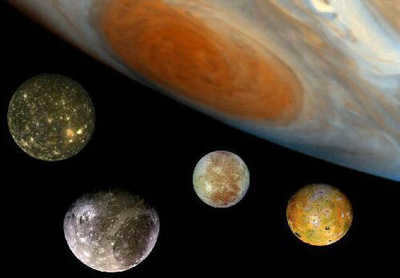
The gravitational force determines the weight of any object, as we were taught in high school physics classes. This force is directly proportional to the mass of the planet and inversely proportional to the square of its radius. Therefore, it is evident that the weight of an object placed on the surface of a planet will vary depending on the planet’s size and magnitude.
Even on Earth, the weight of an object fluctuates due to its non-spherical shape. The Earth is flattened at the poles and elongated along the equator. Consequently, an individual weighing 80 kilograms at the Polar Circle would lose approximately 0.5 kilograms at the equator.
What about the weight of a person on different planets in the solar system?
The weight of Mercury is only 1/20th of the weight of Earth. This planet was first observed through radio astronomical measurements in 1961 by American scientists Howard, Barrett, and Haddock. In the 1970s and 2011, the Mariner and Messenger spacecraft were dispatched to explore Mercury. If a person weighing 80 kg were on Mercury, their weight would be just slightly over 30 kg.
Venus
Venus is often referred to as the “sister planet” of Earth due to its similar mass and size. In fact, Venus is just slightly smaller than our home planet. Research conducted by Soviet scientists at the Korolev Rocket and Space Corporation Energia, who launched the Venera-1 spacecraft in 1967, revealed that the gravitational pull on Venus is not significantly different from that on Earth. If a person weighed 80 kilograms on Earth, they would weigh approximately 72.5 kilograms on Venus.
Mars
Mars weighs 10.7% of the Earth’s weight. Scientists from various countries, including the United States, the USSR, and India, have been actively studying Mars since the 1960s. They have sent missions like Mars and Phobos (USSR), Mariner, Viking (USA), and Mangalyan (India) to explore the planet.
Thanks to these missions, we now know that a person weighing 80 kg on Earth would weigh only 30 kg on Mars.
Jupiter, with a mass of 318 times that of Earth, has been extensively studied through the use of spacecraft such as Pioneer (USSR), Voyager (USA), and others. These missions have provided valuable insights into Jupiter’s atmosphere, mass, and other important parameters.
If a person weighing 80 kg were to be on Jupiter, their weight would be a staggering 189 kg. However, it is important to note that this weight is measured at the upper cloud layer and not the solid surface, which remains largely unexplored by scientists.
Saturn
The weight of Saturn is equivalent to 95 times the weight of the Earth. Currently, Saturn has been extensively studied using the Hubble Space Telescope, as well as through missions like Pioneer and Voyager spacecraft.
As one reaches the outer layer of Saturn’s clouds, the gravitational force experienced by any object becomes similar to that on Earth, meaning that 80 kilograms here would weigh around 73 kilograms. This is due to the planet’s remarkably low density, which is even less than that of water.
Uranus
Research conducted through the “Voyager-2” mission has provided scientists with valuable insights into the characteristics of Uranus. One significant discovery is that the mass of Uranus is equivalent to 14 times the mass of Earth. Interestingly, despite this substantial mass, the low density of Uranus would result in a negligible difference in weight for a person standing on its surface compared to their weight on Earth. For instance, an individual weighing 80 kilograms on Earth would only experience a slight reduction to 71 kilograms on Uranus.
Neptune
Neptune possesses a mass equivalent to 17 times that of Earth. This “gas giant”, located at such a vast distance from the Sun that it is occasionally referred to as the “ice giant”, would cause a person weighing 80 kg on Earth to weigh approximately 90 kilograms.
Pluto
This minuscule celestial body, with a mass only 0.0025 times that of Earth (meaning it is a staggering 500 times lighter than Earth!), was first discovered in 1930. Soviet scientists in the 1950s proposed that Pluto is not a planet in the strictest sense, but rather belongs to a group of celestial bodies known as “dwarf planets”. In 2006, Pluto lost its designation as a planet and was reclassified as one of these dwarf planets. A person weighing 80 kilograms on Earth would weigh a mere 5 kilograms on Pluto.
The Moscow Planetarium announced that on the night of Saturday, June 17, there will be a parade of planets in the sky. Mercury, Jupiter, Saturn, Uranus, and Neptune will be lined up in a single line, forming an acute angle with the horizon. The five celestial bodies will be visible above the eastern horizon, slightly to the right. Mercury will be closest to the horizon, followed by Uranus, Jupiter, Neptune, and Saturn from left to right. The best visibility in Moscow will be around 1 a.m., a couple of hours before dawn. Jupiter will be the brightest, while Uranus and Neptune will be dimmer. Observing the last two planets may prove to be challenging.
Official NTV social media accounts
NTV mobile apps
© NTV Television Company JSC, 1993-2023. All rights reserved.
When using NTV materials, please include a reference (for websites – hyperlink to www.ntv.ru).
By accessing this site, you agree to abide by the terms of this agreement.
Regulations on the Processing and Protection of Personal Data at NTV Television Company JSC
The online edition “NTV.RU” is registered with the Federal Service for Supervision of Communications, Information Technology and Mass Media (Roskomnadzor). Certificate of registration of mass media El No. FS 77-69486 of 25.04.2017.

